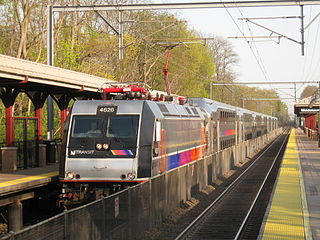
Commuter rail, or suburban rail, is a passenger rail transport service that primarily operates within a metropolitan area, connecting commuters to a central city from adjacent suburbs or commuter towns. Commuter rail systems are considered heavy rail, using electrified or diesel trains. Distance charges or zone pricing may be used.

Rail transport is a means of transport using wheeled vehicles running in tracks, which usually consist of two parallel steel rails. Rail transport is one of the two primary means of land transport, next to road transport. It is used for about 8% of passenger and freight transport globally, thanks to its energy efficiency and potentially high speed.

Transportation in Boston includes roadway, subway, regional rail, air, and sea options for passenger and freight transit in Boston, Massachusetts. The Massachusetts Port Authority (Massport) operates the Port of Boston, which includes a container shipping facility in South Boston, and Logan International Airport, in East Boston. The Massachusetts Bay Transportation Authority (MBTA) operates bus, subway, short-distance rail, and water ferry passenger services throughout the city and region. Amtrak operates passenger rail service to and from major Northeastern cities, and a major bus terminal at South Station is served by varied intercity bus companies. The city is bisected by major highways I-90 and I-93, the intersection of which has undergone a major renovation, nicknamed the Big Dig.

Light rail transit (LRT) is a form of passenger urban rail transit characterized by a combination of tram and rapid transit features. While its rolling stock is similar to that of a traditional tram, it operates at a higher capacity and speed and often on an exclusive right-of-way. In many cities, light rail transit systems more closely resemble, and are therefore indistinguishable from, traditional underground or at-grade subways and heavy-rail metros.
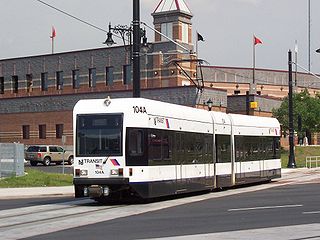
The Newark Light Rail (NLR) is a light rail system serving Newark, New Jersey and surrounding areas, owned by New Jersey Transit and operated by its bus operations division. The service consists of two segments, the original Newark City Subway (NCS), and the extension to Broad Street station. The City Subway opened on May 16, 1935, while the combined Newark Light Rail service was officially inaugurated on July 17, 2006.

The Dublin Area Rapid Transit system is an electrified commuter rail railway network serving the coastline and city of Dublin, Ireland. The service makes up the core of Dublin's suburban railway network, stretching from Greystones, County Wicklow, in the south to Howth and Malahide in north County Dublin. The DART serves 31 stations and consists of 53 route kilometres of electrified railway, and carries in the region of 20 million passengers per year. In a similar manner to the Berlin S-Bahn, the DART blends elements of a commuter rail service and a rapid transit system.

A loading gauge is a diagram or physical structure that defines the maximum height and width dimensions in railway vehicles and their loads. Their purpose is to ensure that rail vehicles can pass safely through tunnels and under bridges, and keep clear of platforms, trackside buildings and structures. Classification systems vary between different countries, and gauges may vary across a network, even if the track gauge is uniform.
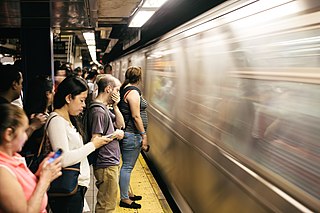
A rush hour or peak hour is a part of the day during which traffic congestion on roads and crowding on public transport is at its highest. Normally, this happens twice every weekday: once in the morning and once in the afternoon or evening, the times during which most people commute. The term is often used for a period of peak congestion that may last for more than one hour.
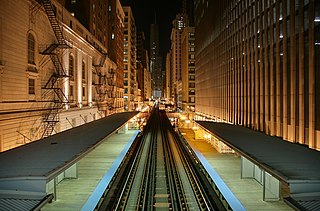
Urban rail transit is a wide term for various types of local rail systems providing passenger service within and around urban or suburban areas. The set of urban rail systems can be roughly subdivided into the following categories, which sometimes overlap because some systems or lines have aspects of multiple types.
Various terms are used for passenger railway lines and equipment; the usage of these terms differs substantially between areas:
Bombardier Transportation was a Canadian-German rolling stock and rail transport manufacturer, with headquarters in Berlin, Germany. It was one of the world's largest companies in the rail vehicle and equipment manufacturing and servicing industry. Bombardier Transportation had many regional offices, production and development facilities worldwide. It produced a wide range of products including passenger rail vehicles, locomotives, bogies, propulsion and controls. In February 2020, the company had 36,000 employees, and 63 manufacturing and engineering locations around the world. Formerly a division of Bombardier Inc., the company was acquired by French manufacturer Alstom on 29 January 2021.
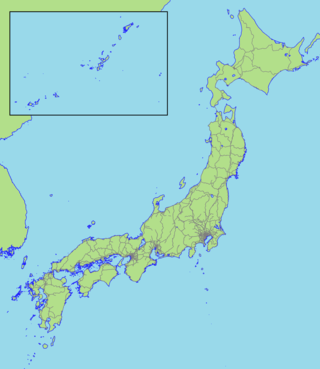
Rail transport in Japan is a major means of passenger transport, especially for mass and high-speed travel between major cities and for commuter transport in urban areas. It is used relatively little for freight transport, accounting for just 0.84% of goods movement. The privatised network is highly efficient, requiring few subsidies and running with extreme punctuality, though since privatisation several unprofitable but socially valuable lines have been closed by private operators.
An airport rail link is a service providing passenger rail transport from an airport to a nearby city by mainline or commuter trains, rapid transit, people mover, or light rail. Direct links operate straight to the airport terminal, while other systems require an intermediate use of people mover or shuttle bus.

The transport network in Greater Tokyo includes public and private rail and highway networks; airports for international, domestic, and general aviation; buses; motorcycle delivery services, walking, bicycling, and commercial shipping. While the nexus is in the central part of Tokyo, every part of the Greater Tokyo Area has rail or road transport services. There are also a number of ports offering sea and air transport to the general public.

A rail replacement bus service uses buses to replace a passenger train service on a temporary or permanent basis. The train service that is replaced may be of any type such as light rail, tram, streetcar, commuter rail, regional rail or heavy rail, intercity passenger service. The rail service may be replaced if the line is closed because of rail maintenance, a breakdown of a train, a rail accident or a strike action or to simply provide additional capacity or if the rail service is not economically viable.
A through service is a concept of passenger transport that involves a vehicle travelling between lines, networks or operators on a regularly specified schedule, on which the passenger can remain on board without alighting. It may be in form of either the following:
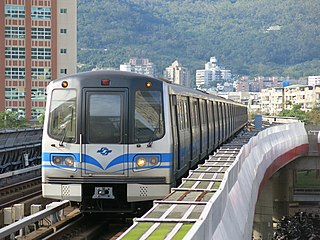
Rapid transit or mass rapid transit (MRT), also known as heavy rail or metro, is a type of high-capacity public transport that is generally built in urban areas. A rapid transit system that primarily or traditionally runs below the surface may be called a subway, tube, or underground. Unlike buses or trams, rapid transit systems are railways, usually electric, that operate on an exclusive right-of-way, which cannot be accessed by pedestrians or other vehicles. They are often grade-separated in tunnels or on elevated railways.

Public transport is a system of transport for passengers by group travel systems available for use by the general public unlike private transport, typically managed on a schedule, operated on established routes, and that may charge a posted fee for each trip. There is no rigid definition of which kinds of transport are included, and air travel is often not thought of when discussing public transport—dictionaries use wording like "buses, trains, etc." Examples of public transport include city buses, trolleybuses, trams and passenger trains, rapid transit and ferries. Public transport between cities is dominated by airlines, coaches, and intercity rail. High-speed rail networks are being developed in many parts of the world.

A circle route is a public transport route following a path approximating a circle or at least a closed curve.

Route capacity is the maximum number of vehicles, people, or amount of freight than can travel a given route in a given amount of time, usually an hour. It may be limited by the worst bottleneck in the system, such as a stretch of road with fewer lanes. Air traffic route capacity is affected by weather. For a metro or a light rail system, route capacity is generally the capacity of each vehicle, times the number of vehicles per train, times the number of trains per hour (tph). In this way, route capacity is highly dependent on headway. Beyond this mathematical theory, capacity may be influenced by other factors such as slow zones, single-tracked areas, and infrastructure limitations, e.g. to useful train lengths.

















